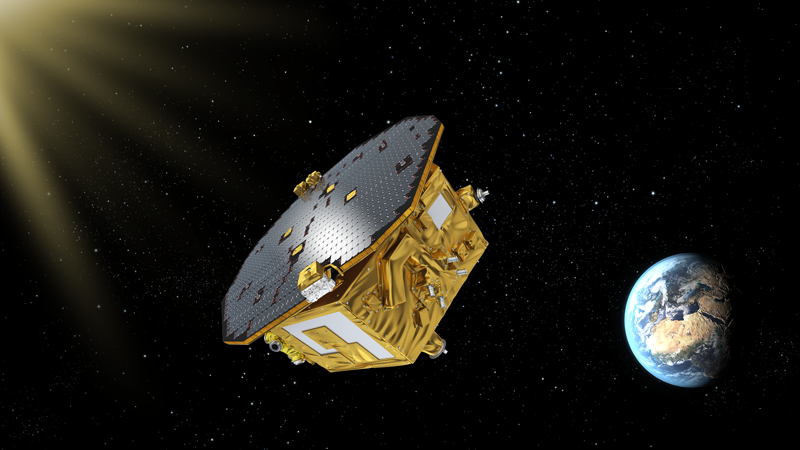Paving the Way to Space-Based Gravitational-Wave Detectors

An artist’s conception of the LISA Pathfinder spacecraft in orbit at Lagrange Point 1. Photovoltaic solar cells on the top of the spacecraft provide power. Micronewton thrusters can be seen on the sides of the spacecraft. The test masses and laser interferometer readout system are located inside the spacecraft
David Reitze, LIGO Laboratory, California Institute of Technology, Pasadena, CA 91125, USA
June 7, 2016• Physics 9, 63
The first results from the LISA Pathfinder mission demonstrate that two test masses can be put in free fall with a relative acceleration sufficiently free of noise to meet the requirements needed for space-based gravitational-wave detection.
The announcement in February 2016 that the Laser Interferometer Gravitational-wave Observatory (LIGO) had detected gravitational waves from the merger of two black holes stunned and electrified much of the physics and astronomy communities [1]. However, while all eyes were turned toward LIGO, the LISA Pathfinder (LPF)—a technology demonstration mission for the Laser Interferometer Space Antenna (LISA) gravitational-wave detector [2]—was quietly but convincingly paving the way toward the next revolution in gravitational-wave astronomy more than 1.5 million kilometers away from Earth. After a six-month program that began with the launch of the spacecraft in early December 2015, the team behind LPF has now announced the first results from the mission [3]. Following a 50-day journey to Lagrange Point 1 of the Sun-Earth system, LPF settled into orbit to begin a series of spacecraft acceptance tests and an observing campaign to measure the limits with which two test masses can achieve free fall.
LPF was designed to test many of the key technologies needed by LISA. LISA will target a much lower gravitational-wave frequency band than LIGO, from about 100 mHz to 1 Hz. This regime is sensitive to gravitational waves from mergers of intermediate to massive black holes in the range of 10^4 to 10^7 solar masses, as well as from mergers of black holes that have an extreme mass ratio (in which one black hole is much more massive than the other). But it necessitates a space-based platform to avoid low-frequency noise sources arising on Earth, which easily overwhelm the signal from such waves. These mergers will provide the most stringent tests of General Relativity in the strong-gravity regime.
See full text